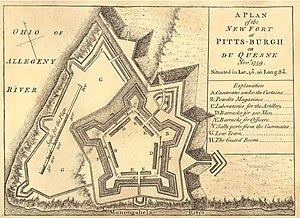| Siege of Fort Pitt | |||||||
|---|---|---|---|---|---|---|---|
| Part of Pontiac's War | |||||||
 "A Plan of the New Fort at Pitts-Burgh", drawn by cartographer John Rocque and published in 1765. | |||||||
| |||||||
| Belligerents | |||||||
| Ohio Country natives | Great Britain | ||||||
| Commanders and leaders | |||||||
| Guyasuta |
Simeon Ecuyer William Trent | ||||||
The siege of Fort Pitt took place during June and July 1763 in what is now the city of Pittsburgh, Pennsylvania, United States. The siege was a part of Pontiac's War, an effort by Native Americans to remove the Anglo-Americans from the Ohio Country and Allegheny Plateau after they refused to honor their promises and treaties to leave voluntarily after the defeat of the French. The Native American efforts of diplomacy, and by siege, to remove the Anglo-Americans from Fort Pitt ultimately failed.
This event is known for an possible attempt at biological warfare, in which William Trent and Simeon Ecuyer, a Swiss mercenary in British service, may have given items from a smallpox infirmary as gifts to Native American emissaries with the hope of spreading the deadly disease to nearby tribes. The effectiveness is unknown, although it is known that the method used is inefficient compared to respiratory transmission and these attempts to spread the disease are difficult to differentiate from epidemics occurring from previous contacts with colonists.[1][2]